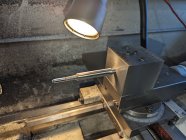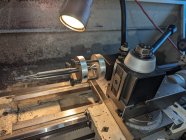LVLAaron
Gold $$ Contributor
What's the tolerance of the reamer mfg's shank? I bet you'll find that you'll need multiple rigid holders if you want a fit as good as you made on your initial holder.
If I were to attempt this I'd be looking for a high quality straight shank er collet chuck. Then I'd mount a solid block where my tool post goes and bore that with the boring bar mounted in the lathe chuck. Bore it with about a .001 interference fit and shrink it in.
You'd be relying on the quality of the collet chuck and collets you purchase but the reamer would be held solid and you could feed it in with the compound to have a good feel of how it's cutting.
Check out the couple of threads @dustin_drews posted recently. He did exactly that.












